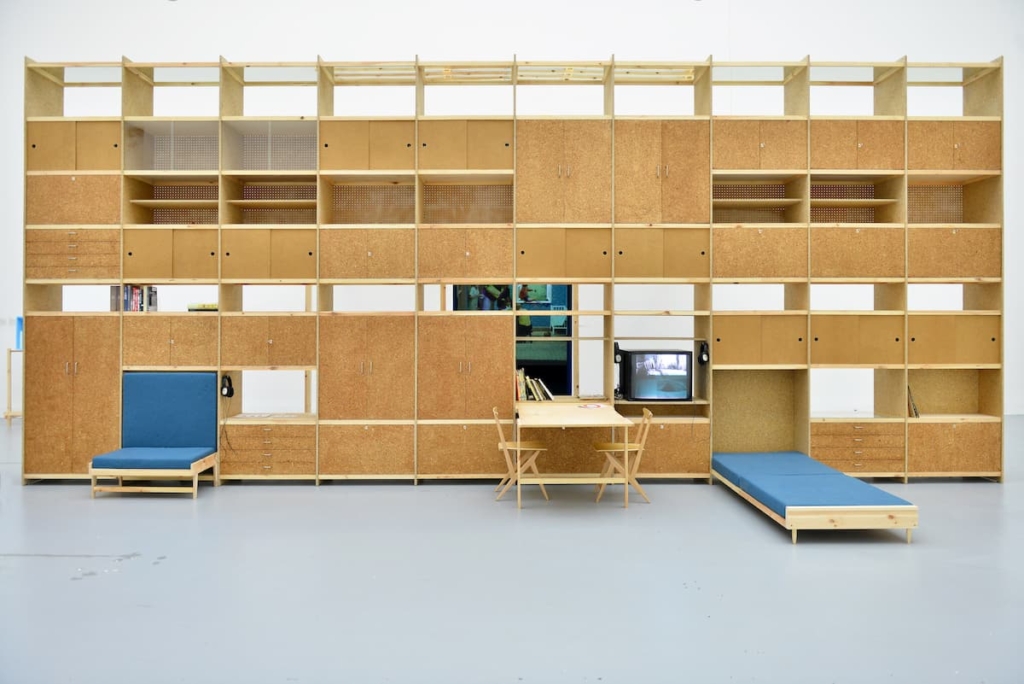Architecture and power
Discussion (in Polish)A panel accompanying the Impossible Figures exhibition (2014) showed the connections between architecture and power, both in a historical and contemporary context.

In the non-pandemic reality, the 17th Venice Architecture Biennale would have already been taking place, featuring the exhibition Trouble in Paradise at the Polish Pavilion. Despite the original plans to postpone the opening from May to August, the organizers have decided that the International Architecture Exhibition – La Biennale di Venezia will take place in 2021. So waiting for the next biennale, we devote the latest edition of the Zachęta On-line Magazine to architecture – not only at the Polish Pavilion, but also at the Zachęta.
The successes of Polish representatives in Venice in recent years have been mainly associated with the Architecture Exhibition. The most spectacular achievements include the Golden Lion for the National Pavilion in 2008 (exhibition: Hotel Polonia. The Afterlife of Buildings, curators: Grzegorz Piątek, Jarosław Trybuś). The jury’s special mention for Katarzyna Krakowiak’s project Making the walls quake as if they were dilating with the secret knowledge of great powers in 2012 (curator: Michał Libera). But the presentations at the Polish Pavilion have evoked not only interest, but also discussion, e.g. the 2016 exhibition Fair Building, devoted to ethical issues related to the work of the least appreciated participants of the architectonic process – construction workers. The magazine revisits Dorota Leśniak-Rychlak’s interview with the Venice project curator Dominika Janicka. Just two years before, in 2014, the biennale was entirely devoted to celebrating 100 years of modernity Created at the Polish Pavilion by the Institute of Architecture and Jakub Woynarowski, the exhibition Impossible Objects dealt with the relations between modernism and politics in the context of building a modern Polish state between the two world wars. We recommend the recording of lectures and discussions Architecture and power accompanying the exhibition, showing shows these relations both in historical and contemporary perspective.
As regards our historical exhibitions, we bring back Oskar Hansen and Bohdan Urbanowicz’s exhibition presented in the Polish Pavilion at the 37th International Biennale in Venice and shown at the Zachęta in 1977. How did the Polish artists respond to the biennale’s main theme: Environment, Participation, Cultural Structures? You will find out the answer to this question in Marek Czapelski’s text. The Venice projects have been regularly displayed at the Zachęta, even though they are rarely a one-to-one reconstruction of the Polish Pavilion. Katarzyna Krakowiak’s exhibition The Rise and Fall of Air (2013) provides an interesting example of such an adaptation. A year earlier the artist converted the Venice pavilion into a sculpture emitting sound. She used the same method working with the architecture of the Zachęta, although she turned the gallery’s building into a sound absorbing structure. You will see (and hear) the effect in the exhibition’s video documentation. We also recall the project that did not win the competition for the Polish Pavilion, but found its place at the Zachęta. Inspired by Zbigniew Rybczyński’s Oscar-winning animation Tango, Tango on 16 square metres (2018) tells the story of efforts aimed to improve contemporary urban living conditions. We recommend the photos documenting the exhibition.
In the seventh issue of our magazine, we have decided to show the architectural themes in our collection exemplified by Alicja Karska and Aleksandra Went’s video performance Spatial Planning and Organisation (2002) and the installation YMCA by Aneta Grzeszykowska and Jan Smaga. In Grzeszykowska and Smaga’s rendering, the “model” is turned inside out – rather than the exterior it shows the interior of the historical building located on Konopnicka Street in Warsaw.
We encourage you to take time to read our magazine at zacheta.art.pl and to visit https://labiennale.art.pl, where you will find information about the latest project prepared for the Venice Architecture Biennale and about historical exhibitions at the Polish Pavilion.
The new issue of the magazine is devoted to architecture. We begin with an interview with Dominika Janicka, curator of the Fair Building exhibition presented at the Polish Pavilion at the 15th Architecture Biennale in Venice.
